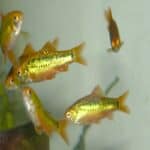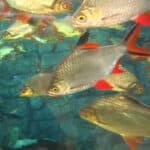If you’re after an attractive tank of fish, then Cherry Barb are great additions. But they’re not just pretty to look at, they’re also easy to care for. Below we’ll tell you everything you need to know about these fish: how to care for them, how to breed them, and what conditions they thrive in.

Species Summary
Cherry Barb (or Punitius Titteya) are a popular freshwater fish among aquarists, and they hail from Sri Lanka. However, you can also find the Cherry Barb in Columbia and Mexico.
This is far away from their native Sri Lanka, and the appearance of Cherry Barb in Central American countries has been facilitated by humans. However, the Cherry Barb have adapted well to these new waters!
Cherry Barb are currently listed as vulnerable on the IUCN Red List. This is partly due to their popularity among aquarists and people capturing more Cherry Barb than they should.
Their shrinking natural habitat is another reason as to why they’re considered vulnerable. A lot of the waters these fish would have called home have either become uninhabitable or have disappeared all together.
Care Guide
Tank size: 25 to 30 gallons is the recommended tank size for Cherry Barb. This is the adequate size for a school of fish without them being too crowded.
Because Cherry Barb are schooling fish you should never get just one, so despite being a rather small fish you do need a decent-sized tank to house a school of them.
Tank mates: Cherry Barb are peaceful fish, meaning they will get on well with a variety of tank makes. However, it’s crucial not to pair these fish with aggressive or larger species. For example, you should avoid pairing Cherry Barb with Betta fish.
Some of the best fish to pair with Cherry Barb would be Asian Stone Cats, Dwarf Gourami, Kuhli Loach, Molly Fish, Neon Tetra, Otocinclus, Pearl Gourami, and Rainbow Sharks. Non-fish species that get on well with Cherry Barb are the Cherry Shrimp and Mystery Snail.
Same species tanks: As we’ve mentioned, Cherry Barb are highly social and need to be in a group to be active. If you only have a few Cherry Barbs then they’ll be more likely to hide than swim. Large groups make them more confident and mean you’ll be able to enjoy their presence in the tank.
You should also have a 2:1 ratio of females to males. This will help to prevent male aggression during spawning.
Water parameters: Cherry Barb are also appealing because of the flexibility of their water parameters. They have a very generous range, and while they are hardy fish you should still keep levels as consistent as possible.
Their ideal water temperature would be 73°F to 81°F, while their ideal pH levels are 6 to 8, and their water hardness should be 5 to 19 dH.
Make sure to perform regular water tests with a reliable and accurate water test kit to make sure these parameters are being met. Doing this makes it easier to spot a problem and make necessary adjustments.
What to put in their tank: Keep the natural habitat of the Cherry Barb in mind when setting up their tank. They naturally live in shallow and calm waters that have lots of vegetation on the surface. Therefore, a well-planted tank is crucial. Anacharis, Hornwort, and Water Wisteria plants are great additions.
Meanwhile, substrate is also important. Cherry Barb live in waters where the substrate is dark and silty, and their tanks need to mimic this environment. Darker sand is a good place to start, and also gives the tank an appealing look. The bright red color of Cherry Barb really stands out in darker environments!
You can also include driftwood, caves and rocks, as long as they don’t hinder the school’s ability to swim freely and explore the tank.
Common diseases: Cherry Barb are very durable fish, meaning they don’t contract diseases very easily. However, without the optimal habit and diet their health will deteriorate.
You should also always be on the alert for ICH, a freshwater disease. You will know your Cherry Barb has ICH by white spots that appear on their body. You may also notice some behavioral changes.
Cherry Barb can also fall victim to other infections and parasites, so inspect your fish every once in a while. Taking a few minutes everyday to check for anything out of the ordinary makes a big difference.
Food & diet: Cherry Barb are omnivorous and in the wild will eat anything they can get their hands, or um, fins on! They’ll eat little pieces of plants that land in the water, as well as tiny insects, worms, algae and plankton.
In a tank you should feed them high-quality food flakes, and this is what they will derive most of their nutrients from. Foods rich in protein like bloodworms and brine shrimp are also recommended, and will make the diet of your Cherry Barb more varied.
Be careful not to overfeed these fish as this can lead to health problems. Keep an eye on how much you’re feeding them, and if they haven’t eaten all their food in a couple of minutes consider reducing their portions next time.
Lifespan
With a good level of care, and optimal water conditions, habitat setup and tank mates the average lifespan of Cherry Barb is between 5 and 7 years.
Appearance
What initially draws people to Cherry Barb is their appearance. As their name suggests, their entire bodies are a bright cherry red. But they do have a dark line that runs down the middle of their sides, from mouth to caudal fin.
Because the line is slightly faded, it can look like a dotted line when viewed from the right angle. They have a very long and thin body shape, which makes them fast and hydrodynamic.
Their fins are smaller than other species of Barb. The dorsal fin starts in the middle of their body and resembles a half shell. When they are swimming particularly fast their fins pull back a bit.
Meanwhile, their anal and pectoral fins are moderately sized, and they have a forked caudal fin that is symmetrical on the top and bottom.
Their fins are all slightly translucent.
Size
Cherry Barb can grow up to 2 inches in length when fully grown. Depending on the level of care and genetic factors they can also stop growing at 1 inch.
Behaviour and Temperament
Cherry Barb are pretty active fish. Unless they’re around threatening tank mates they don’t stay still!
Because of their schooling nature you’ll often see them swimming around together, and this is because they’ll feel safer in a group than on their own.
You may see one fish leave the school to take a look at something but they will always return to the group. They’re very peaceful fish, preferring to stick to their school and mind their own business.
The only time you’ll see the fish become aggressive is during mating. Males will chase females as well as other males in order to mate or establish dominance.
Breeding
It’s fairly easy to breed Cherry Barb. Unlike other species, breeding them doesn’t take a lot of work. In fact, there is more prep work than anything else because the mating pair and eggs will need the right tank and habitat conditions.
The mating pair will need a smaller tank than usual, and the eggs will need a tank of their own. Cherry Barb will eat their eggs in captivity if they’re not separated.
The breeding tank also needs to be well-planted. This is because in the wild Cherry Barb use plants to hide and protect their eggs, so if plants are not present in their tank then they won’t lay their eggs.
A Cherry Barb lays lots of eggs, up to 100 in fact! So it’s important that a new tank is prepared for the eggs to be moved into and that they are moved quickly. While some aquarists will use specific tools to do this, as long as you have a way to move their eggs quickly and easily then tools are not really necessary.
The eggs will hatch within a couple of days. Once the fish have hatched you should feed them micro eels and then brine shrimp as they grow. These foods are the perfect fuel to support their rapid growth.
Gender Differences: Male vs Female
Male Cherry Barb are more colorful than female Cherry Barb. They’re usually a more vibrant red, while females are paler and with more translucent fins.
Fun Facts
- Cherry Barb are capable of hearing things, but they also rely on vibration to know what’s going on around them.
- Male Cherry Barb don’t need to be present when the female Cherry Barb is laying her eggs. In fact, after the eggs are scattered, the fishes leave the eggs to their own devices. This can lead to a low survival rate for the eggs, which is why monitoring them in captivity is so important.








